Press Release
SURFING FOR LIFE: Inspirational Film on Older Surfers
Presented by KQED to public television stations nationwide Available April 14, 2001 via American Public Television (APT). (check local listings for time and station).
SURFING FOR LIFE, an entertaining and inspirational portrait of ten older surfers still riding waves in their 60s, 70s, 80s and 90s, will be distributed by American Public Television to public television stations nationwide beginning April 14, 2001. Produced and directed by award-winning filmmaker David L. Brown, this remarkable documentary journey portrays the “sport of kings” as a uniquely powerful metaphor for passionate involvement and life’s possibilities as we all grow older. This is a film for all audiences that details the fascinating lives of heroic role models who are “following their bliss” and staying active and engaged into their seventh, eighth and ninth decades.
Narrated by acclaimed actor Beau Bridges, SURFING FOR LIFE blends compelling life stories told through interviews, contemporary day-in-the-life footage, and a wealth of rare archival material including images from several of the world’s finest early surf filmmakers and photographers. Through these insightful profiles and a healthy dose of humor, this dynamic film challenges the negative images of aging presented in America’s youth-obsessed culture.
SURFING FOR LIFE not only challenges ageism, it also weaves a tapestry of unforgettable stories that embody many universal aspects of the human experience. The surfers’ tales reveal, among many lessons, courage in the face of adversity, the power of the human spirit and a celebration of values and relationships that contribute to rich, meaningful, well-spent lives. Some examples:
After living through the attack on Pearl Harbor, John Kelly (age 81) is transformed into a life-long peace activist;
Anona Napoleon (age 60) survived a paralyzing diving accident then used faith, will and visualization to achieve a miraculous full recovery;
Woody Brown (age 88) feeling reborn after “working with love” as a volunteer at an adult day health center; and
Fred Van Dyke (age 70) speaking for everyone who is dealing with the challenges of aging as he copes with the painful decision to quit surfing 25 foot waves at age 60.
With life-embracing warmth and humor, the older surfers in SURFING FOR LIFE overturn the common perception of surfing as an activity only for young people and, in the process, make an important and eloquent statement about the human potential of later life. Audiences and critics alike confirm that this is one of the most memorable and uplifting films on growing older ever produced.
SURFING FOR LIFE Subject Bios
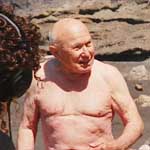 John H. “Doc” Ball at 93 is the oldest living American surfer, and he still skateboards and surfs without a wetsuit in Shelter Cove in Northern California. He has been riding waves since 1929 and wrote the classic book about early California surfing, CALIFORNIA SURFRIDERS (1946). A dentist and a professional photographer, he captured more classic surf images from the 1930s through the ’50s than any other photographer. He co-founded the State’s first surf club in Palos Verdes, is a great storyteller, a legend among surfers (and surf photographers) and a warm and generous spirit, still “stoked” about life. His fearless skateboarding sequence is the unforgettable ending to SURFING FOR LIFE.
John H. “Doc” Ball at 93 is the oldest living American surfer, and he still skateboards and surfs without a wetsuit in Shelter Cove in Northern California. He has been riding waves since 1929 and wrote the classic book about early California surfing, CALIFORNIA SURFRIDERS (1946). A dentist and a professional photographer, he captured more classic surf images from the 1930s through the ’50s than any other photographer. He co-founded the State’s first surf club in Palos Verdes, is a great storyteller, a legend among surfers (and surf photographers) and a warm and generous spirit, still “stoked” about life. His fearless skateboarding sequence is the unforgettable ending to SURFING FOR LIFE.
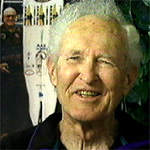 LeRoy “Granny” Grannis, 83 and a surfer for 67 years, he was Doc Ball’s best friend for over 70 years. He has excelled at several professions–military pilot, phone company executive, photographer–and has raised four children. Like his old friend Doc, Granny has shot countless classic surfing photos from the 1950s to the present. The founding photographer of SURFING Magazine, he began hang-gliding in his 50s and sailboarding in his 60s. His recent surf photography book PHOTO: GRANNIS, profiles “surfing’s golden age, 1960-69” and has received great acclaim. Photos by Doc and Granny (and the work of many other surf photographers) help to illustrate the life histories of several of the subjects and pioneering surfing communities in Surfing for Life. Granny and his older surfing friends spread half of Doc’s ashes in the Palos Verdes Cove memorial to Doc.
LeRoy “Granny” Grannis, 83 and a surfer for 67 years, he was Doc Ball’s best friend for over 70 years. He has excelled at several professions–military pilot, phone company executive, photographer–and has raised four children. Like his old friend Doc, Granny has shot countless classic surfing photos from the 1950s to the present. The founding photographer of SURFING Magazine, he began hang-gliding in his 50s and sailboarding in his 60s. His recent surf photography book PHOTO: GRANNIS, profiles “surfing’s golden age, 1960-69” and has received great acclaim. Photos by Doc and Granny (and the work of many other surf photographers) help to illustrate the life histories of several of the subjects and pioneering surfing communities in Surfing for Life. Granny and his older surfing friends spread half of Doc’s ashes in the Palos Verdes Cove memorial to Doc.
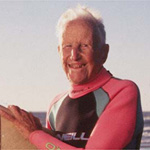 Woody Brown is 88 and lives in Maui, Hawai’i where he surfs every chance he gets. He became a national flying hero in the ’30s, a Hawaiian big wave surf hero in the ’40s and–after inventing the catamaran–a yachting world celebrity in the ’50s. Woody’s great stories are illustrated by several of the classic photos and film footage of him surfing huge Hawaiian waves in the ’40s and ’50s. His sequence as a volunteer at an Adult Day Health Center in Maui where he is “working with love” clearly reveals Woody’s extraordinary compassion, charm and humor.
Woody Brown is 88 and lives in Maui, Hawai’i where he surfs every chance he gets. He became a national flying hero in the ’30s, a Hawaiian big wave surf hero in the ’40s and–after inventing the catamaran–a yachting world celebrity in the ’50s. Woody’s great stories are illustrated by several of the classic photos and film footage of him surfing huge Hawaiian waves in the ’40s and ’50s. His sequence as a volunteer at an Adult Day Health Center in Maui where he is “working with love” clearly reveals Woody’s extraordinary compassion, charm and humor.
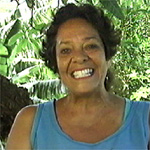 Anona Napoleon, a 60-year-old Hawaiian native, has surfed for 48 years in Hawaii. She was a championship surfer and kayaker in the late ’50s and ’60s, winning the prestigious Makaha International Surfing Championship in 1961. This victory followed a miraculous recovery from a paralyzing accident only a year earlier. A warm and gracious example of Hawaii’s “Aloha spirit,” she is a college humanities lecturer who has five sons and nine grandchildren who surf–often together. Her family’s “Napoleon’s Holiday,” when the full extended family skips school and work to spend the day together surfing, is a high point of SURFING FOR LIFE.
Anona Napoleon, a 60-year-old Hawaiian native, has surfed for 48 years in Hawaii. She was a championship surfer and kayaker in the late ’50s and ’60s, winning the prestigious Makaha International Surfing Championship in 1961. This victory followed a miraculous recovery from a paralyzing accident only a year earlier. A warm and gracious example of Hawaii’s “Aloha spirit,” she is a college humanities lecturer who has five sons and nine grandchildren who surf–often together. Her family’s “Napoleon’s Holiday,” when the full extended family skips school and work to spend the day together surfing, is a high point of SURFING FOR LIFE.
 Fred Van Dyke, 70, is a legendary pioneer of big wave surfing. He moved from California to Hawai’i in the ’50s to surf the big waves, taught with his friend Peter Cole at Punahou School and wrote several classic surf books including 30 YEARS OF SURFING THE WORLD’S BIGGEST WAVES. A physical fitness enthusiast, Fred still surfs the 10-footers regularly and gives multi-media presentations on healthy aging and surfing throughout the country. The emotional center of SURFING FOR LIFE is his recent painful decision to confront his fear and give up surfing the huge waves with which he had become so identified.
Fred Van Dyke, 70, is a legendary pioneer of big wave surfing. He moved from California to Hawai’i in the ’50s to surf the big waves, taught with his friend Peter Cole at Punahou School and wrote several classic surf books including 30 YEARS OF SURFING THE WORLD’S BIGGEST WAVES. A physical fitness enthusiast, Fred still surfs the 10-footers regularly and gives multi-media presentations on healthy aging and surfing throughout the country. The emotional center of SURFING FOR LIFE is his recent painful decision to confront his fear and give up surfing the huge waves with which he had become so identified.
 Rabbit Kekai is 79 and a legendary Hawaiian beach boy, waterman and world-class big wave surfer. He began surfing at age five in 1925, became the first practitioner of “hot-dog surfing” and nose-riding in the late 1930s, then became a top beach boy to the stars. Winner of countless international surfing contests, he is still a world-class competitive surfer, story-teller and another gracious embodiment of the Aloha Spirit. He recalls that his eyes still “light up” when his wife says, “Go surfing.”
Rabbit Kekai is 79 and a legendary Hawaiian beach boy, waterman and world-class big wave surfer. He began surfing at age five in 1925, became the first practitioner of “hot-dog surfing” and nose-riding in the late 1930s, then became a top beach boy to the stars. Winner of countless international surfing contests, he is still a world-class competitive surfer, story-teller and another gracious embodiment of the Aloha Spirit. He recalls that his eyes still “light up” when his wife says, “Go surfing.”
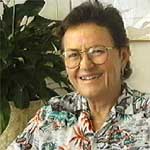 Shay Bintliff, M.D. (64) is an emergency room physician, mother of two and surfer for 35 years. She has travelled the world, studied with Meher Baba in India and performed stand-up comedy. When the surf was good, she recalls leaving word with her secretary that she was off to a “board meeting.” Extremely energetic and affable, she embraces life, love, nature and the challenges of aging in her wise observation that “change is inevitable; it’s the growth that optional.” Her stories about peak experiences and family are high points of the documentary.
Shay Bintliff, M.D. (64) is an emergency room physician, mother of two and surfer for 35 years. She has travelled the world, studied with Meher Baba in India and performed stand-up comedy. When the surf was good, she recalls leaving word with her secretary that she was off to a “board meeting.” Extremely energetic and affable, she embraces life, love, nature and the challenges of aging in her wise observation that “change is inevitable; it’s the growth that optional.” Her stories about peak experiences and family are high points of the documentary.
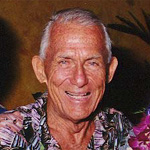 John Kelly, 80, is a renowned pioneer of Hawaiian big-wave surfing and one of the first surf board designers. A war hero, musician, conductor and dedicated political activist, he founded the seminal environmental organization “Save Our Surf” in 1965 which has opposed environmental threats to Hawaii’s coastal zone and blocked over 30 proposed developments. His sequence recounting the Pearl Harbor attack and its aftermath — when his Navy job forced him to place dead American and Japanese soldiers face to face in the same coffin, an experience which transformed him into a life-long activist — is a high point of the film.
John Kelly, 80, is a renowned pioneer of Hawaiian big-wave surfing and one of the first surf board designers. A war hero, musician, conductor and dedicated political activist, he founded the seminal environmental organization “Save Our Surf” in 1965 which has opposed environmental threats to Hawaii’s coastal zone and blocked over 30 proposed developments. His sequence recounting the Pearl Harbor attack and its aftermath — when his Navy job forced him to place dead American and Japanese soldiers face to face in the same coffin, an experience which transformed him into a life-long activist — is a high point of the film.
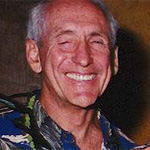 Peter Cole, 69, is another legendary big wave surfer who has been surfing for over 50 years. He graduated from Stanford, followed Van Dyke to Hawaii, taught at Punahou and is now a computer consultant. Like his friend Fred Van Dyke, Peter is extremely fit and continues to be a world-class gentleman and surfer. Unlike Fred, though, Peter continues to surf the giant waves on the North Shore of Oahu, the oldest surfer to do so. One of the most memorable scenes in SURFING FOR LIFE captures Fred and Peter playfully debating whether they skipped mandatory meetings at Punahou School when the surf was up.
Peter Cole, 69, is another legendary big wave surfer who has been surfing for over 50 years. He graduated from Stanford, followed Van Dyke to Hawaii, taught at Punahou and is now a computer consultant. Like his friend Fred Van Dyke, Peter is extremely fit and continues to be a world-class gentleman and surfer. Unlike Fred, though, Peter continues to surf the giant waves on the North Shore of Oahu, the oldest surfer to do so. One of the most memorable scenes in SURFING FOR LIFE captures Fred and Peter playfully debating whether they skipped mandatory meetings at Punahou School when the surf was up.
 Eve Fletcher, at 73 is one of the oldest women still surfing. A surfer for 40 years, she had a successful career as an animation supervisor for Disney Studios where she worked on SLEEPING BEAUTY, CINDERELLA and hundreds of films. She still surfs regularly with several surfers over 70 at San Onofre, the home of more surfers over 70 than any other beach in the world. Another high point of the film is classic 1958 footage of Eve and her friend “on surfin’ safari” in Hawai’i where she became friends with Rabbit Kakai and lived in Fred Van Dyke’s van which she bought for $75.
Eve Fletcher, at 73 is one of the oldest women still surfing. A surfer for 40 years, she had a successful career as an animation supervisor for Disney Studios where she worked on SLEEPING BEAUTY, CINDERELLA and hundreds of films. She still surfs regularly with several surfers over 70 at San Onofre, the home of more surfers over 70 than any other beach in the world. Another high point of the film is classic 1958 footage of Eve and her friend “on surfin’ safari” in Hawai’i where she became friends with Rabbit Kakai and lived in Fred Van Dyke’s van which she bought for $75.
PRODUCTION CREDITS
Writer and Director: David L. Brown
Producers: David L. Brown, Roy Earnest
Narrator: Beau Bridges
Editors: David L. Brown, Shirley Thompson
Camera: David L. Brown, David Collier, Stephen Lighthill and others
Sound: Elizabeth Thompson, Steven Baigel, Rob Caughlan
Music Composition: Tom Disher; Sound Design: Paul Zahnley
Executive Producer: Seniority, Inc.
Presenting Station: KQED San Francisco
One paragraph synopsis
SURFING FOR LIFE, a vibrant , 68 minute documentary about inspiring well-spent lives, offers a totally fresh look at successful aging. Narrated by Beau Bridges, it profiles ten older surfers who model successful aging by staying active and engaged into their 7th, 8th and 9th decades. Through interviews, contemporary day-in-the-life footage, and a wealth of rare archival material, the film provides an eloquent and powerful antidote to the negative images of aging presented in America’s youth-obsessed culture.
CO-PRODUCER/ DIRECTOR/ WRITER BIOGRAPHICAL INFO
David L. Brown is a three-time Emmy Award-winning San Francisco documentary filmmaker who has produced, written and directed over 80 productions and 17 broadcast documentaries on a variety of topics and issues. His documentaries have received over 85 international awards and three Emmy Awards, and have been broadcast on PBS and in sixteen other countries. His recent work includes: Going the Distance: Journeys of Recovery, profiling the injuries and recoveries of four survivors of traumatic brain injury, that won Most Inspirational Film at the Oregon Documentary Film Festival and aired nationally on PBS; Keeper of the Beat: A Woman’s Journey into the Heart of Drumming, that won runner-up for the Audience Award for Best Documentary at the 2013 Mill Valley Film Festival; Running for Jim, a feature-length documentary on a legendary cross country coach who contracts ALS (Lou Gehrig’s Disease) that won Best Documentary, Soho International Film Festival and the Audience Award, Tiburon Film Festival; The Bridge So Far: A Suspense Story, a comedic 56-minute documentary on the troubled history of the new east span of the S.F.-Oakland Bay Bridge that received two Emmy Awards (Best Documentary and Best Graphics and Animation in a Program) and aired on national PBS; Seniors for Peace, a half-hour portrait of an extraordinarily passionate and articulate group of senior peace activists (average age 84) that aired on PBS; Of Wind and Waves: The Life of Woody Brown; an hour-long profile of legendary 94-year-old surfer/sailor, Woody Brown (Emmy nomination for Best Documentary, Inspiration Award at Mountainfilm in Telluride) that aired on national PBS; and Surfing for Life, a feature-length documentary on older surfers as models of healthy aging. It screened theatrically in 40 cities, was broadcast on over 180 PBS stations, won 15 international awards, and was profiled in The New York Times Magazine, Parade Magazine, on National Public Radio and ABC’s World News Tonight with Peter Jennings. The San Francisco Chronicle called it “a treasure..perhaps the most intelligent treatment of surfing ever captured on film.”
Brown produced three hour-long films on nuclear issues culminating in Bound by the Wind, a documentary on the global human and environmental legacy of nuclear weapons testing and the plight of the world’s “downwinders.” The Boston Globe called Bound by the Wind “far and away the best film on the nuclear legacy.” He produced three film festivals on nuclear and environmental issues and a week-long festival honoring the documentary pioneers, the Maysles Brothers: The Al Maysles Memorial Film Festival.
For twenty two years, Brown taught Documentary Filmmaking and the History of Documentary at City College of San Francisco. He has also taught filmmaking classes at U.C. Berkeley Extension, Diablo Valley College, Film Arts Foundation and San Francisco Film Society. His website is www.DLBfilms.com

